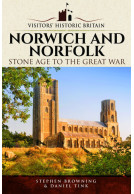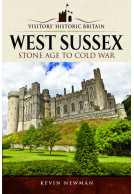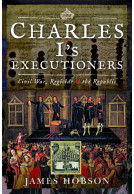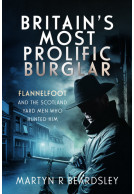Visitors' Historic Britain: Northumberland (ePub)
Romans to Victorians
Imprint: Pen & Sword History
Series: Visitors' Historic Britain
File Size: 6.1 MB (.epub)
Pages: 136
Illustrations: 30
ISBN: 9781526702807
Published: 16th March 2020
| Other formats available | Price |
|---|---|
| Visitors' Historic Britain: Northumberland Paperback Add to Basket | £12.99 |
Northumberland…to the Romans it was Ad Fines, the limit of the Empire, the end of the Roman World. It was here in 122 AD that the Emperor Hadrian decided to build a wall stretching from coast-to-coast to provide protection, to show the might of the Empire, and as a statement of his grandeur. Visitors to Northumberland can walk the Wall visiting milecastles, Roman frontier forts and settlements such as Housesteads (where you can see the oldest toilets you’ll ever see) or Vindolanda (where you can take part in an archaeological dig) where wooden tablets detailing life on this frontier (the oldest example of written language in Britain) were discovered, or the remains of Roman temples and shrines (such as the Mithraeum at Carrawburgh). After the Romans left, Northumberland became the heart of one of the greatest kingdoms of Anglo-Saxon Britain, Northumbria. The home of Saints, scholars and warrior kings. Visitors can see the ancient seat of this kingdom at the medieval Bamburgh Castle, visit Hexham Abbey (built in 674 AD), or tour the magnificent remains of the 7th century Priory at Tynemouth (where three kings are buried – Oswin (d. 651), Osred (d. 790), and the Scottish King Malcolm III (d. 1093).
No other county in Britain has as many medieval remains as Northumberland. From the most grand such as Alnwick Castle (known as the Windsor of the North, the home of the Dukes of Northumberland, the capital of Northumberland, and, to many, Hogwarts!) to humble remains such as the Chantry at Morpeth. At Warkworth visitors can tour the medieval church (scene of a 12th century Scottish massacre), Warkworth Castle (another Percy possession and the setting for a scene in Shakespeare’s Henry IV), a medieval hermitage, and the fortified bridge gatehouse (one of the only surviving examples in Britain).
Northumberland was ravaged during the Anglo-Scottish Wars and this led to the development of family clans of Border Reivers who were active during the 16th and early 17th centuries. Raiders, looters, blackmailers and courageous cavalrymen the Reivers have left many surviving remnants of their harsh time. Peel Towers dot the landscape alongside Bastle Houses. The active can even walk in the footsteps of the Reivers by following the Reivers Way long distance path.
Victorian Northumberland was dominated by both farming and, increasingly, by the industrial genius of some of its entrepreneurs. The greatest of these, Lord Armstrong (known as the Magician of the North), has left behind one of the most magnificent tourist sites in Britain; his home at Cragside. Carved from a bare hillside and transplanted with millions of trees and shrubs and crowned with the beautiful Cragside House visitors can walk the grounds taking advantage of various trails and spotting wildlife such as red squirrels before visiting the first house in the world to be lit by electricity!
Northumberland is part of the Pen & Sword Visitors Historic Britain series, all useful and interesting books, each of which covers the main historic buildings and sites in its county in a short publication with up-to-date information on access, prices, etc. and well illustrated. Northumberland is one of the best simply because the county has such a rich heritage, despite being the least densely populated shire in England.
Edward James, Historical Novels Review
The strength of his [Armstrong] guides is that they are fully user-friendly.
Fortress Study Group, April 2020 - reviewed by Gil Dowdall-Brown
Armstrong employs a simple anecdotal narrative; he doesn’t talk down to his audience and conveys a deal of information without overload. Northumberland contains many sites of interest to both FSG and CSG colleagues and this guide is in- valuable.
As featured by
Hexham Local History Society, Summer 2020
Armstrong covers in some details the history of Northumberland and the places he recommends visiting. He includes directions to places and fascilities available.
Rosie Writes
The size and organisation is extremely useful. A reader can decide the era they are interested in and find them easily.
Read the full review here
Steeped in history, and part of the ancient kingdoms of Britain following the departure of the Romans, Northumberland through the ages right up until the Victorian age is described in this fascinating and enthralling book by Craig Armstrong.
Books Monthly
An entertaining and useful format. Twenty five different places to visit across Northumberland, spanning every era from a Roman fort to Emily Wilding Davison's grave.
Alnwick FHS - reviewed by Dudley George
Each venue has an detailed introductory history and how to get to it, although in a rural county this is inevitably mainly by car.
Invaluable to any first time visitor to Northumberland and a good top-up of knowledge, even for locals like me.
I really enjoyed this book and found that even though I have visited the county a fair few times there was still plenty that I found to be new to me and I have a lot on my list now of places to visit in the area – it is a really handy guide and I loved the amount of history that was packed into the book.
Donnas Book Blog
I liked the amount of images that were in the book, it helped illustrate the different chapters as the book takes you through the history of Northumberland from the Romans to the Victorians.
I enjoyed the way that the book was set out and the facts and detail added were excellent. The author has added in details of the sites (where possible) and the addresses/contact numbers so you can make your own arrangements.
It is 5 stars from me for this book – thoroughly enjoyable and it will be a great reference guide to for those visiting the area – I am really looking forward to going back!
Read the full review here
About Dr Craig Armstrong
Born and bred in Northumberland, Dr Craig Armstrong is an experienced historian,with a special interest in the history of the North East of England and Scotland. He works as a freelance author and has taught history at both Newcastle University and Northumbria University.

























